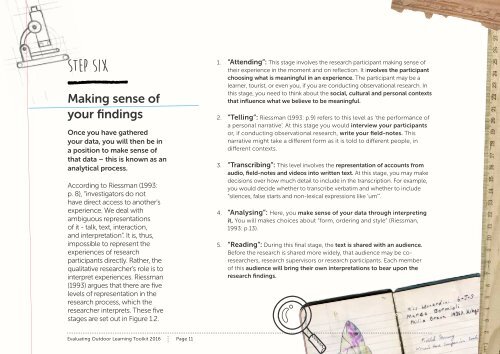EVALUATING THE OUTDOOR LEARNING EXPERIENCE
2cZM4EO
2cZM4EO
You also want an ePaper? Increase the reach of your titles
YUMPU automatically turns print PDFs into web optimized ePapers that Google loves.
STEP SIX<br />
Making sense of<br />
your findings<br />
Once you have gathered<br />
your data, you will then be in<br />
a position to make sense of<br />
that data – this is known as an<br />
analytical process.<br />
According to Riessman (1993:<br />
p. 8), “investigators do not<br />
have direct access to another’s<br />
experience. We deal with<br />
ambiguous representations<br />
of it - talk, text, interaction,<br />
and interpretation”. It is, thus,<br />
impossible to represent the<br />
experiences of research<br />
participants directly. Rather, the<br />
qualitative researcher’s role is to<br />
interpret experiences. Riessman<br />
(1993) argues that there are five<br />
levels of representation in the<br />
research process, which the<br />
researcher interprets. These five<br />
stages are set out in Figure 1.2.<br />
1. “Attending”: This stage involves the research participant making sense of<br />
their experience in the moment and on reflection. It involves the participant<br />
choosing what is meaningful in an experience. The participant may be a<br />
learner, tourist, or even you, if you are conducting observational research. In<br />
this stage, you need to think about the social, cultural and personal contexts<br />
that influence what we believe to be meaningful.<br />
2. “Telling”: Riessman (1993: p.9) refers to this level as ‘the performance of<br />
a personal narrative’. At this stage you would interview your participants<br />
or, if conducting observational research, write your field-notes. This<br />
narrative might take a different form as it is told to different people, in<br />
different contexts.<br />
3. “Transcribing”: This level involves the representation of accounts from<br />
audio, field-notes and videos into written text. At this stage, you may make<br />
decisions over how much detail to include in the transcription. For example,<br />
you would decide whether to transcribe verbatim and whether to include<br />
“silences, false starts and non-lexical expressions like ‘um’”.<br />
4. “Analysing”: Here, you make sense of your data through interpreting<br />
it, You will makes choices about “form, ordering and style” (Riessman,<br />
1993: p.13).<br />
5. “Reading”: During this final stage, the text is shared with an audience.<br />
Before the research is shared more widely, that audience may be coresearchers,<br />
research supervisors or research participants. Each member<br />
of this audience will bring their own interpretations to bear upon the<br />
research findings.<br />
Evaluating Outdoor Learning Toolkit 2016 Page 11


